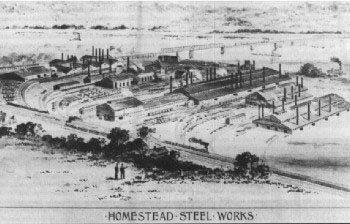The Homestead Strike 1892
by Cheri Goldner
For almost five months in 1892, the Homestead lodges of the Amalgamated Association of Iron and Steel Workers and the Carnegie Steel Company, Limited clashed over contract negotiations in what has become known as The Homestead Strike.
The steel industry was crucial to Homestead, a borough situated on the left bank of the Monongahela River, just seven miles east of Pittsburgh (see map). In 1889, workers had won a strike and negotiated a three-year contract for a sliding scale wage which was determined by the fluctuating market prices of 4 x 4 standard Bessemer steel billets. The contract was to expire on June 30, 1892.
As this expiration date neared, steel baron Andrew Carnegie, who had often publicly communicated union sympathies, departed for Scotland leaving the notorious Henry Clay Frick with managing authority. Frick was known for his ruthless anti-union policy and as negotiations were still taking place he ordered the construction of a solid board fence topped with barbed wire around mill property. The workers dubbed the newly fortified mill "Fort Frick."
Meetings continued through late June but the two sides could not reach an agreement. Workers expressed their discontent by hanging Frick and superintendent J.A. Potter in effigy on mill property and turning the hose on the men sent by Potter to cut the effigies down. With this event as an excuse, the company began to shut down the works on June 28. By the morning of June 30, the day the contract with the Amalgamated expired, the entire work force was locked out.
Union and non-union workers joined forces under the leadership of Hugh O'Donnell and kept guard around the steel works to prevent any blacksheep, or scabs, from entering. Frick meanwhile, had already made arrangements with Pinkerton's National Detective Agency of New York for the arrival of 300 strike-breaking detectives, commonly known as "Pinkertons."

When this army was spotted on the Monongahela in the early morning of July 6, workers sounded alarms and townspeople of all ages gathered to meet the approaching barges. Once it was clear that the detectives planned on docking at and entering mill property, workers tore through a company fence to stop them.
While who fired the first shot remains a mystery, the detectives opened fire on the crowd and wounded several workers. The workers hid behind ramparts of steel, pig iron and scrap iron and returned fire while the women and children retreated out of range. The battle lasted from 4 a.m. on July 6 until 5 p.m., with workers finally agreeing to the surrender of the Pinkertons. Three Pinkertons and seven workers died and many more were wounded in the fight.
Six days later the National Guard of Pennsylvania arrived in Homestead under the orders of Governor Robert E. Pattison. The company then used several tactics to weaken union forces. They evicted workers from company homes, arrested individuals repeatedly just to charge them bail, and involved the workers in a series of costly court cases.
On November 17, the first break in the ranks occurred when day laborers and mechanics voted to return to work. Three days later the lodges of the Amalgamated voted to lift the prohibition on returning to work for the company. The company hired back some of them as non-union workers and blacklisted others. Carnegie, Frick and company had won, helping to prevent the organization of the mills for the next forty years.


No comments:
Post a Comment